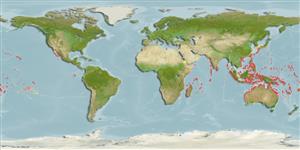>
Blenniiformes (Blennies) >
Tripterygiidae (Triplefin blennies) > Tripterygiinae
Etymology: Helcogramma: Greek, helkos, -eos, -ous = ulcer, sore + Greek, gramma = letter, mark (Ref. 45335).
More on author: Herre.
Environment: milieu / climate zone / depth range / distribution range
นิเวศวิทยา
เกี่ยวกับทะเล,น้ำเค็ม สัตว์น้ำหน้าดิน; ระดับความลึก 2 - 10 m (Ref. 6211), usually 2 - 5 m (Ref. 48636). Tropical
Indo-Pacific: widely distributed. The species complex is being revised by J.T. Williams.
ขนาด / น้ำหนัก / Age
Maturity: Lm ? range ? - ? cm
Max length : 5.7 cm SL เพศผู้/กระเทย; (Ref. 6211)
Short description
เครื่องมือที่ใช้ในการแยกชนิดสัตว์,สิ่งมีชีวิตออกจากกัน | สัณฐานวิทยา | ความยาวต่างๆ
เงี่ยงครีบหลัง (รวม) : 16; ก้านครีบอ่อนที่หาง (รวม) : 9 - 10; เงี่ยงครีบก้น: 1; ก้านครีบอ่อนที่ก้น: 18 - 20; สัตว์มีกระดูกสันหลัง: 34 - 35. Diagnosis: Dorsal fin III + XIII+ 9-10, second fin same height of first; anal fin I + 18; pectoral rays 16 (1+8+7); pelvic fin I, 2, spine short and hidden, segmented rays simple, partially united by membrane. Vertebrae 10 + 24-25. LL total lateral scales 36-38, pored series 33-37 (21) scales; nape, belly, and anal-fin base scaleless, caudal fin base with only 1 row of scales. Mandibular pores 5-7+3-5+5-7. Orbital cirrus flat and palmate. Head length 3.5 in SL; eye 2.8; maxilla 2.3 in HL. Male head dark brown on top, reddish above eye, black and blue below, with narrow stripe from maxilla to preopercle; body brownish grey with 3 pale saddles; belly pink. Female head white with red and brown spots below, shading darker and with brown blotches above, with brown stripe from upper lip to corner of eye; body white with brown oblique semi-bars and blotches on dorsal half of side (Ref. 75031). Males distinctly colored during courtship, but look drab at other times (Ref. 48636).
Adults inhabit rocky boulders from depths of 2 to 5 m, common at depths less than 10 m (Ref. 6211). They live in small groups, each comprising a male and several females (Ref. 48636) on rock surfaces and under ledges and tidepools (Ref. 75031). Eggs are hemispherical and covered with numerous sticky threads that anchor them in the algae on the nesting sites (Ref. 240). Larvae are planktonic which occur primarily in shallow, nearshore waters (Ref. 94114).
Life cycle and mating behavior
Maturities | การสืบพันธุ์ | Spawnings | Egg(s) | Fecundities | ตัวอ่อน
Hansen, P.E.H., 1986. Revision of the tripterygiid fish genus Helcogramma, including descriptions of four new species. Bull. Mar. Sci. 38(2):313-354. (Ref. 6211)
IUCN Red List Status (Ref. 130435)
Threat to humans
Harmless
Human uses
เครื่องมือ
Special reports
Download XML
แหล่งที่มาจากอินเตอร์เน็ต
Estimates based on models
Preferred temperature (Ref.
123201): 24.7 - 29.3, mean 28.3 °C (based on 3300 cells).
Phylogenetic diversity index (Ref.
82804): PD
50 = 0.5000 [Uniqueness, from 0.5 = low to 2.0 = high].
Bayesian length-weight: a=0.00562 (0.00258 - 0.01228), b=3.08 (2.89 - 3.27), in cm total length, based on LWR estimates for this (Sub)family-body shape (Ref.
93245).
ระดับชั้นอาหาร (Ref.
69278): 3.1 ±0.3 se; based on size and trophs of closest relatives
ความสามารถในการกลับคืนสู่ปกติ (Ref.
120179): ความสูง, เวลาต่ำสุดที่จะทำให้ประชากรเพิ่มขึ้นเป็น 2 เท่าใช้เวลาน้อยกว่า 15 เดือน (Preliminary K or Fecundity.).
Fishing Vulnerability (Ref.
59153): Low vulnerability (10 of 100).
